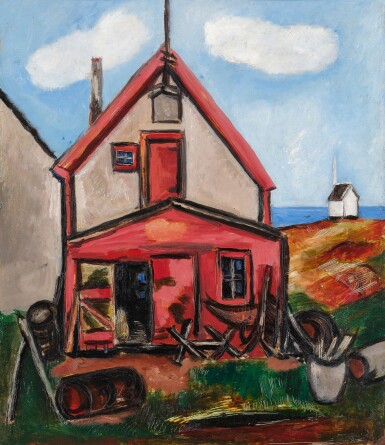Modern Day Auction
Modern Day Auction

Property from the Collection of Robin Bradley Martin
Marsden Hartley
Pink House
Auction Closed
May 16, 09:00 PM GMT
Estimate
80,000 - 120,000 USD
Lot Details
Description
Property from the Collection of Robin Bradley Martin
Marsden Hartley
1877 - 1943
Pink House
oil on board
14 by 12 in.
35.6 by 30.5 cm.
Executed in 1940-41.
This work is included in The Marsden Hartley Legacy Project: Complete Paintings and Works on Paper, Bates College Museum of Art, Lewiston, Maine.
Estate of the artist
Paul Rosenberg & Co., New York (acquired circa 1945)
Babcock Galleries, New York (acquired from the above in 1958)
A. Bradley Martin, Long Island, New York (acquired from the above in 1958)
Acquired by descent from the above by the present owner
G. Alan Chidsey, Volume of Photographs of Paintings, Pastels, Drawings and Lithographs by Marsden Hartley, G. Alan Chidsey Papers, Archives of American Art, Washington, D.C., N69-115, frames 27-403
Elizabeth McCausland Papers, bulk 1920-1960, Series 6: Marsden Hartley, Archives of American Art, Smithsonian Institution, Washington, D.C.
New York, Paul Rosenberg & Co., Paintings by Marsden Hartley, January 1950, no. 12, n.p.
New York, Babcock Galleries, Marsden Hartley, 1877-1943, December 1958 - January 1959, no. 21., n.p.
In 1937, Marsden Hartley returned to his native state of Maine. After years spent in Germany, New York, and Mexico, the artist began his “campaign to shed the label of expatriate and to publicize himself as a regional artist” (Elizabeth Mankin Kornhauser, Marsden Hartley, New Haven, 2002, p. 125). The Maine of Hartley’s youth was lonely, marred by a sense of isolation after his mother’s death. However, as an adult, Hartley felt at home along its rocky shores. In Maine, Hartley found something “strong, simple, stately… a kind of stark poetry” (Marsden Hartley, “On the Subject of Nativeness– a Tribute to Maine” in Marsden Hartley: Exhibition of Recent Paintings, New York, 1926), pp. 1-2). The artist also found a warm, welcoming community– for three years, Hartley would live in Corea, a rural fishing village, with lobsterman Forest Young and his wife, Katie. It was there that Hartley likely painted Pink House.
The eponymous house is disarmingly direct. It faces the viewer with an open door, contents cluttering the yard. The house appears to be abandoned, though the effect is more beautiful than unsettling– the structure remains unabashedly, vividly pink, framed by soft skies and a glimpse of brilliant blue sea. A chapel gleams in the background, possibly the village’s Baptist Church which Hartley occasionally painted. Pink House saw Hartley explore a new textural technique, carving into the painted surface to yield fine detail in the grass, windows, and lobster trap at right, the thin marks contrasting wonderfully with his thick brushwork. Altogether, there is a poignancy to Pink House, the work cast with surprising, nostalgic warmth.
You May Also Like









